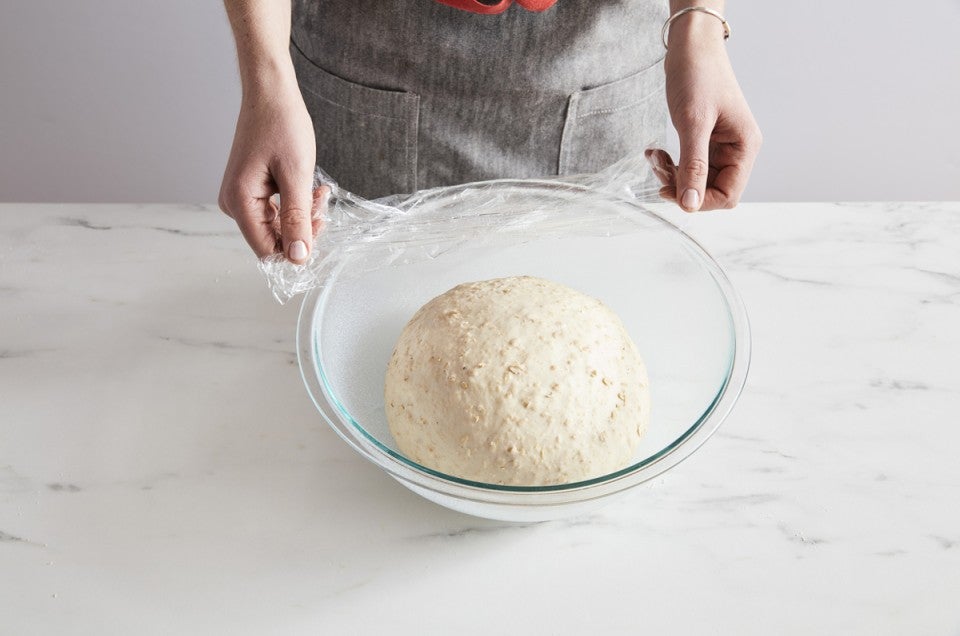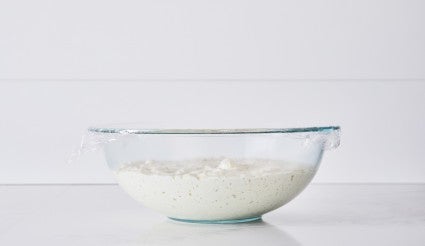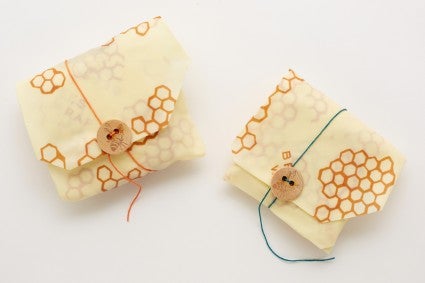How can I get single-use plastic out of my baking?
Simple switches can help cut down on how much plastic we waste when we bake.


I didn’t really think about how much plastic was in my baking until I started paying attention. There were the sandwich bags I stuffed with leftover brownies. The disposable pastry bags I used to pipe swirls of buttercream. And the plastic wrap ... so much plastic wrap. To cover my proofing bread dough, store my leftover cake, wrap my frozen cookies, and plenty more.
I’ve been thinking deeply about how I can incorporate more environmentally friendly practices into my baking, and one thing has become clear: Decreasing my consumption of single-use plastic is a necessary place to start.
As with most topics related to environmental sustainability, there are no clear-cut, easy answers to the problem of plastic. But after a little bit of searching, I found a lot of ways to leave the plastic wrap on the roll. How you bake in your own kitchen depends on your individual circumstances, and what’s right for me may not be the best choice for you. But if you’re tired of buying plastic baggies only to throw them away a week later, read on.

The meaning of single-use plastic is right there in the name: It’s meant to be used one time, then discarded. In baking, the most common example is plastic wrap, used for countless important tasks — everything from storing leftover baked goods to preventing doughs from drying out.
Of course, there are ways to reuse plastic products intended for a single use, like washing a plastic sandwich bag. That said, such products will eventually wear down, and in time they’ll have to be discarded and replaced.
According to a report by the Center for International Environmental Law, “plastic proliferation threatens our planet and the climate at a global scale.” That threat is for a variety of reasons. For one, making plastic products is resource-intensive; the more we use plastic, the more resources are required to make more of it. According to that same report, “Nearly every piece of plastic begins as a fossil fuel, and greenhouse gases are emitted at each stage of the plastic lifecycle.”
Then, once disposed of, plastic can wind up in oceans and lead to waterway pollution, something the United Nations has deemed “a planetary crisis.” It can also end up in landfills, where it takes a long time to degrade, if at all. That discarded plastic leads to microplastics that leach into the soil, where it can have a damaging effect on soil health. What’s more, discarded plastic that ends up in landfills and incinerators can release greenhouse gasses that contribute to global climate change; according to this report by the EPA, in 2016 more than half the emissions from the incineration of waste in the U.S. was attributable to the combustion of plastics.
It’s clear plastic consumption is a huge issue for our planet. And sure, it can be hard to grasp how one less sheet of plastic wrap really makes a difference. But personally, I’m trying to do all I can to minimize my negative impact on our planet. This is something we can all seek to address in every part of our lives, but as bakers, here are some ways we can eliminate use specifically in our kitchens.
(Heads up: At King Arthur, we only recommend the products that we, as bakers, truly love. When you buy through external links on our site, we may earn an affiliate commission.)

This is one area in which I use the most plastic. Instead of automatically reaching for that roll of plastic wrap, try using something else to keep doughs from drying out:
Bee’s Wrap: You may be familiar with this product, a washable, reusable, and fully biodegradable wrap that clings, sticks, and seals like plastic. It’s great for covering bowls and pans, plus wrapping pie dough while it chills (and plenty of other uses — this won’t be the last time it’s recommended).
Plates, pans, and lids: As long as a plate, pan, or saucepan lid is big enough to cover a bowl opening and flat enough to be fully flush to the rim, it makes a nice DIY reusable bowl cover.
Reusable bowl covers or storage bowls with a reusable lid: Of course, if you bake a lot you might want to upgrade to a real reusable bowl cover. These are big favorites for many King Arthur bakers. You can also find sheet pans with reusable covers for bakes like cinnamon rolls or bagels.
Dough-rising buckets: Basically a storage bowl with a lid, but made specifically for bread!
Old produce or grocery bags: If you do have plastic bags lying around (though it’s best to avoid this additional instance of single-use plastic!), they can be used as bowl covers. Ditto for plastic shower caps — they can be reused for a very long time.
An upside-down bowl: Really! As fellow baker Kye demonstrates in the video below (skip ahead to the 12:40 mark), you can just turn your work bowl upside down over rising dough. (This doesn’t work well for super-wet or sloppy doughs.)
I’m not going to lie: It’s convenient to use disposable pastry bags because you can simply toss them in the trash instead of painstakingly washing clean. And there is a sustainability trade-off: The hot water needed to wash canvas bags gives them an environmental footprint. But since I’m trying to be better about avoiding single-use plastic specifically, I’m using …
Reusable pastry and piping bags: OK, cleaning them really isn’t that bad. A thorough rinse under hot water gets rid of most of the frosting, and soon your bag is ready to pop back in the drawer. Which, admittedly, feels a lot better than dumping in the garbage. (Also, fellow blogger PJ Hamel throws hers in the dishwasher, an easy cleaning solution!)
I have a nasty habit of storing leftover baked goods in large plastic zip-top bags, but it’s something I’m trying to address! Here are some great alternatives:
Bee’s Wrap: It’s back! For baked goods stored at room temperature, this is another great use for Bee’s Wrap. For bread specifically, try this Bee’s Wrap Bread Wrapper.
Reusable food bags: A straightforward switch from disposable plastic bags to ones you can use again and again, without worrying about them wearing down.
Old cookie tins: I love packing up my holiday cookies in festive tins, and it took me too long to realize that this doesn’t have to be a December-only practice. Lidded tins will store your baked goods airtight — and if you use one of those blue Royal Dansk tins, you’ll get a hit of nostalgia every time you open it. (This tip works well for treats you’re gifting; more on that in a second.)

Another instance in which plastic zip-top bags are all too convenient. Instead, try some of these other options:
Glass jars and containers: Jars are usually available at thrift stores on the cheap, a great way to find reused materials. Dress them up with bows or twine for a prettier presentation.
Bee’s Wrap (again, I know!): You guessed it: This is another great place to use Bee’s Wrap. It’s like a little bonus gift for your loved one — not only do they get a delicious treat, but also a handy addition to their kitchen.
Old takeout containers: Turn that single-use takeout container into a reusable solution by packing it with giveaway treats.
Your baking pan or a pretty plate: If you’re gifting to a friend or loved one that you see frequently, why not share your baked goods directly in the pan (easier for you!) or on a nice decorative plate — both of which they can return to you when you see them again.*
*In the South, where I’m from, there’s an old unspoken rule that you never return an empty dish — there should always be something in it. Maybe use this as inspiration to start an ongoing baked good swap with a friend!
Of course, these are just a few suggestions for materials to use in your kitchen. You can get creative with all sorts of options: As reported by the New York Times last fall, people turn to everything from old Cool Whip containers to empty gelato pints for home storage, and sometimes, those containers pack as much of an emotional punch as the treats they store.
Do you have any go-to tips or materials to reduce single-use plastic in your kitchen? I’d love to hear them! Please share in the comments below.
Cover photo by Mark Weinberg.


April 14, 2022 at 11:01pm
In reply to My Mother-in-Law taught me… by Kathy Gallant (not verified)
When the air is super dry in winter with the heat on, I slightly dampen the tea towel prior to covering the bowl of dough, it helps avoid the crust in the dough from drying out.
April 13, 2022 at 10:08am
This is a great article but I have already made these changes. It is now my mission to get rid of plastic in my home. Not just single source; use once and throw out plastic, but all of the plastic. It is a mission and it is not easy or cheap but it is worth it as this is the only planet we have and it must be shared with all living faunas and floras.
April 13, 2022 at 10:07am
Thank you, Rossi, for this conscientiousness-raising piece which I'm so happy is a hot topic. Recently I opened the fridge and my heart sunk at the prospect of there being more plastic than food in it: I woke up to the realization that I was not the good steward I liked to think I was just because we recycled. So while (indefinitely) reusable silicone sheets that are supposed to stick to themselves don't without the help of a rubber band, they're excellent alternatives, as are the other alternatives you mentioned. My Grandmother baked bread and fresh pasta at least twice a week and didn't own anything plastic, period. I remember her using perfectly laundered kitchen towels and tablecloths to cover dough and dry pasta, respectively. If we all do our part -- if we all try harder -- good habits will take root. Thank you again for using this platform to address what has now become urgent.
April 16, 2022 at 2:22pm
In reply to Thank you, Rossi, for this… by Joanna McGuire (not verified)
Thanks for your suggestions and kind words, Joanna!
April 13, 2022 at 8:54am
I have long used plastic reusable bowl covers with elastic edges (like shower caps). I am also using Stasher reusable silicone bags to freeze my rolls/buns etc as well as tomatoes and caramelized onions. They are versatile and can go in dishwasher. More costly upfront but less to throw away. And I save cereal bags to use to smash garlic in or make crumbs from crackers or tortillas. I wish Stashers had bags big enough for loaves of bread to freeze, but not yet. I also am looking at what I buy, as in no more plastic packed Crisco. I get the big tubs and weigh the stuff. Another step but less plastic. And Junes makes reusable bags for produce.
April 16, 2022 at 1:59pm
In reply to I have long used plastic… by Sandra R (not verified)
Thanks for these tips, Sandra!
April 12, 2022 at 9:59pm
When I worked at a school years ago, I asked the cooks to save for me any plastic bags they were going to toss (like bread & bun packaging). They were happy to oblige. Then a teacher asked what was going on, so I told her & SHE began saving HER bread wrappers from the store. I have an on-going supply & never have to buy bags. Anything I'm going to freeze, I stick in a used wrapper before putting it in a store-bought freezer bag. I have been using the same box of freezer bags for over 20 years.
April 12, 2022 at 5:48pm
For the second rise of bread in the pan, I use tin foil sprayed with a light coating of food release spray. Then when it's time to cover the baking loaves to prevent over browning, I use the same tin foil again. Then I use the same foil to wrap any bread we haven't gobbled up for storage and/or freezing. The food release spray prevents the foil from sticking while the bread is rising. It's a good way to get multiple uses out of the foil and avoid using plastic wrap.
April 12, 2022 at 2:21pm
Thanks for the climate safe suggestions. I try very hard to think safe for the planet and do use many of your ideas already; but noticed you didn't seem to know about a rather antique way my mom used for keeping baked goods fresh and soft. She had a cake cover made of washable aluminum that had a ceramic disc in the center of the lid. Much like the little clay bear you can buy to keep your brown sugar from getting hard. I bought mine from a thrift store and use it to cover cakes, brownies, cookies, cup cakes, etc. It sits on the kitchen counter for as long as it takes for the goodies to disappear. Good to the last crumb. Maybe this would be a profitable new product?
April 16, 2022 at 11:08am
In reply to Thanks for the climate safe… by Babette (not verified)
Great suggestion, Babette! Thanks for sharing!
Pagination